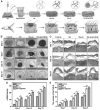Recent Advances in Functional Wound Dressings
- PMID: 36301918
- PMCID: PMC10125407
- DOI: 10.1089/wound.2022.0059
Recent Advances in Functional Wound Dressings
Abstract
Significance: Nowadays, the wound dressing is no longer limited to its primary wound protection ability. Hydrogel, sponge-like material, three dimensional-printed mesh, and nanofiber-based dressings with incorporation of functional components, such as nanomaterials, growth factors, enzymes, antimicrobial agents, and electronics, are able to not only prevent/treat infection but also accelerate the wound healing and monitor the wound-healing status. Recent Advances: The advances in nanotechnologies and materials science have paved the way to incorporate various functional components into the dressings, which can facilitate wound healing and monitor different biological parameters in the wound area. In this review, we mainly focus on the discussion of recently developed functional wound dressings. Critical Issues: Understanding the structure and composition of wound dressings is important to correlate their functions with the outcome of wound management. Future Directions: "All-in-one" dressings that integrate multiple functions (e.g., monitoring, antimicrobial, pain relief, immune modulation, and regeneration) could be effective for wound repair and regeneration.
Keywords: chronic wound; diabetic foot ulcer; hydrogels; nanofibers; sponges; wound dressings; wound healing.
Conflict of interest statement
No competing financial interests exist. The content of this article was entirely written by the authors listed. No ghost-writers were used to write this article.
Figures









Similar articles
-
Natural Polymer-Based Hydrogel Dressings for Wound Healing.Adv Wound Care (New Rochelle). 2025 Jun;14(6):295-322. doi: 10.1089/wound.2024.0024. Epub 2024 Jul 25. Adv Wound Care (New Rochelle). 2025. PMID: 38623809 Review.
-
Comparative efficacy of different functional hydrogel dressings in healing diabetic foot ulcer: A systematic review and network meta-analysis.Diabetes Obes Metab. 2025 Jun;27(6):3431-3441. doi: 10.1111/dom.16367. Epub 2025 Apr 8. Diabetes Obes Metab. 2025. PMID: 40197692
-
Chitosan-based electrospun nanofibers for diabetic foot ulcer management; recent advances.Carbohydr Polym. 2023 Aug 1;313:120512. doi: 10.1016/j.carbpol.2022.120512. Epub 2023 Jan 2. Carbohydr Polym. 2023. PMID: 37182929 Review.
-
Use of bioelectric dressings for patients with hard-to-heal wounds: a case report.J Wound Care. 2023 Oct 1;32(Sup10a):S8-S14. doi: 10.12968/jowc.2023.32.Sup10a.S8. J Wound Care. 2023. PMID: 37830843
-
[Research advances on multifunctional hydrogel dressings for treatment of diabetic chronic wounds].Zhonghua Shao Shang Za Zhi. 2021 Nov 20;37(11):1090-1098. doi: 10.3760/cma.j.cn501120-20210715-00249. Zhonghua Shao Shang Za Zhi. 2021. PMID: 34794262 Free PMC article. Review. Chinese.
Cited by
-
Allogenic Adipose-Derived Stem Cells in Diabetic Foot Ulcer Treatment: Clinical Effectiveness, Safety, Survival in the Wound Site, and Proteomic Impact.Int J Mol Sci. 2023 Jan 12;24(2):1472. doi: 10.3390/ijms24021472. Int J Mol Sci. 2023. PMID: 36674989 Free PMC article.
-
Cytotoxicity and concentration of silver ions released from dressings in the treatment of infected wounds: a systematic review.Front Public Health. 2024 Feb 21;12:1331753. doi: 10.3389/fpubh.2024.1331753. eCollection 2024. Front Public Health. 2024. PMID: 38450128 Free PMC article.
-
Dexketoprofen-Loaded Alginate-Grafted Poly(N-vinylcaprolactam)-Based Hydrogel for Wound Healing.Int J Mol Sci. 2025 Mar 26;26(7):3051. doi: 10.3390/ijms26073051. Int J Mol Sci. 2025. PMID: 40243670 Free PMC article.
-
Wound Dressing with Electrospun Core-Shell Nanofibers: From Material Selection to Synthesis.Polymers (Basel). 2024 Sep 5;16(17):2526. doi: 10.3390/polym16172526. Polymers (Basel). 2024. PMID: 39274158 Free PMC article. Review.
-
A Recent Insight into Research Pertaining to Collagen-Based Hydrogels as Dressings for Chronic Skin Wounds.Gels. 2025 Jul 8;11(7):527. doi: 10.3390/gels11070527. Gels. 2025. PMID: 40710689 Free PMC article. Review.
References
-
- Krishnan KA, Thomas S. Recent advances on herb-derived constituents-incorporated wound-dressing materials: a review. Polym Adv Technol 2019;30:823–838.
-
- Powers JG, Higham C, Broussard K, et al. . Wound healing and treating wounds: chronic wound care and management. J Am Acad Dermatol 2016;74:607–625. - PubMed
Publication types
MeSH terms
Substances
Grants and funding
LinkOut - more resources
Full Text Sources
Medical

